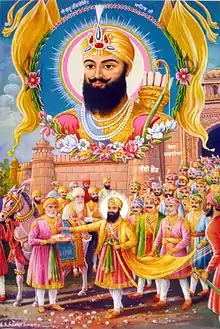Bandi Chhor Divas
Bandi Chhor Divas ("Day of Liberation") is a Sikh celebration that commemorates the day the sixth Guru of Sikhs, Guru Hargobind was released from Gwalior Fort. Emperor Jahangir had held him at the Gwalior Fort for several months. A Sikh Gurdwara, Gurdwara Data Bandi Chhor Sahib, is located at the place of the Gurus internment in the Fort. The day falls in autumn and often overlaps with Hindu Diwali, the festival of lights celebrated across Punjab. Historically, from the time of the third Sikh Guru Amar Das, Sikhs and Hindus of the time used the occasion of Diwali, Vaisakhi and other such festivals to congregate at the seat of the Gurus.[1][2][3] In the late 20th century, Sikh religious leaders and the Shiromani Gurdwara Parbandhak Committee formally adopted this day into the Nanakshahi calendar in 2003, under President Prof. Kirpal Singh Badungar the then president of Shiromani Gurdwara Parbandhak Committee.[4]


The Hindu festival of Diwali is celebrated across all India (and globally) by people of the Hindu, Jain and Sikh faith. Its significance is based on the ancient events and scriptures of Hinduism, while Bandi Chhor Divas celebrates a Sikh historic event related to the sixth Guru, Guru Hargobind. According to history, on this day, Guru Hargobind was able to secure the release of 52 kings, imprisoned by Mughal Emperor Jahangir.[5][6][7]
The Bandi Chhor Divas is celebrated by lighting of homes and Gurdwaras, celebratory processions (nagar kirtan) and langar ( community kitchen). It is an important Sikh celebration along with Vaisakhi, Hola Mohalla and Gurpurab.[4][8]
Description
| Part of a series on |
| Sikhism |
|---|
 |
Bandi Chhor Divas was celebrated when Guru Hargobind sahib ji was released from Gwalior prison with 52 Hindu kings and princes holding on to his robe or cape with 52 ropes.The guru let all 52 innocent rulers to safety without any signs of war or battle. In addition to Nagar keertan (a street procession) and an Akhand paath (a continuous reading of Guru Granth Sahib), Bandi Chhor (Shodh) Divas is celebrated with a fireworks display. The Sri Harmandir Sahib, as well as the whole complex, is festooned with thousands of shimmering lights. The gurdwara organizes continuous kirtan singing and special musicians. Sikhs consider this occasion as an important time to visit Gurdwaras and spend time with their families.[9]
History and significance
Guru Hargobind Shaib's father Guru Arjan Dev was arrested under the orders of the Mughal Emperor Jahangir and he was asked to convert to Islam.[10][11] His refusal led to his torture and execution in 1606 CE.[10][12] This event is a defining moment in the history of India and Sikhs as the martyrdom of Guru Arjan.[10][13] After the execution, Guru Hargobind succeeded his father as the next Guru of Sikhs.[10][14][15]
Guru Hargobind, on 24 June 1606, at age 11, was crowned as the sixth Sikh Guru.[16][17] At his succession ceremony, he put on two swords: one indicated his resolve to maintain spiritual authority (piri) and the other, his temporal authority (miri).[18] Because of the execution of Guru Arjan by Mughal Emperor Jahangir, Guru Hargobind was opposed to the oppression of the Mughal rule. He advised Sikhs and Hindus to arm and fight.[19] The death of his father at the hands of Jahangir prompted him to emphasize the military dimension of the Sikh community.[20]
Different versions exist of how the Guru was imprisoned at Gwalior Fort by Jahangir. One version suggests that when Murtaja Khan, Nawab of Lahore, noticed that the Guru had constructed the Sri Akal Takhat Sahib, 'The Throne of the Almighty', at Amritsar, and was also strengthening his army, he informed the Mughal Emperor Jahangir about this. He also, emphasized that the Sikh Guru was making preparations to take revenge for his father's torture and martyrdom. When Jahangir heard about this he at once sent Wazir Khan and Guncha Beg to Amritsar to arrest Guru Hargobind.
But Wazir Khan, who happened to be an admirer of Guru Hargobind, rather than arresting him, requested the Guru to accompany them to Delhi telling him that Emperor Jahangir wanted to meet him. The young Guru accepted the invitation and soon reached Delhi, where Jahangir interned him at the Gwalior Fort in 1609. Another version speaks of Guru Hargobind's imprisonment on the pretext that the fine imposed on Guru Arjan had not been paid by the Sikhs and Guru Hargobind.[21] It is not clear as to how much time he spent as a prisoner. The year of his release appears to have been either 1611 or 1612, when Guru Hargobind was about 16 years old.[21] Persian records, such as Dabistan i Mazahib suggest he was kept in jail between 1617-1619 in Gwalior, after which he and his camp were kept under Muslim army's surveillance by Jahangir.[22][23] As per some accounts, Guru Hargobind upon his release went to Amritsar, where people were celebrating the festival of Diwali. This important event in Sikh history is now termed the Bandi Chhor Divas festival.[24]
See also
References
- William Owen Cole; Piara Singh Sambhi (1995). The Sikhs: Their Religious Beliefs and Practices. Sussex Academic Press. pp. 135–136. ISBN 978-1-898723-13-4., Quote: "Since the time of Guru Amar Das it has been customary for Sikhs to assemble before their Guru on three of the most important Hindu festival occasions - Vaisakhi, Divali and Maha Shivaratri".
- Kathleen Kuiper (2010). The Culture of India. The Rosen Publishing Group. p. 127. ISBN 978-1-61530-149-2.
- Eleanor Nesbitt (2016). Sikhism: a Very Short Introduction. Oxford University Press. pp. 28–29, 59. ISBN 978-0-19-874557-0.
- Eleanor Nesbitt (2016). Sikhism: a Very Short Introduction. Oxford University Press. pp. 6, 122–123. ISBN 978-0-19-874557-0.
- Phyllis G. Jestice, Holy People of the World: A Cross-cultural Encyclopedia, Volume 1
- Sikhism: A Guide for the Perplexed by Arvind-Pal Singh Mandair
- Knut A. Jacobsen; Kristina Myrvold (2012). Sikhs Across Borders: Transnational Practices of European Sikhs. Bloomsbury Academic. pp. 26–27, 33 with note 19. ISBN 978-1-4411-0358-1.
- Glimpses of Sikhism By Major Nahar Singh Jawandha
- Nikky-Guninder Kaur Singh (2011). Sikhism: An Introduction. I.B.Tauris. p. 86. ISBN 978-0-85773-549-2.
- Pashaura Singh (2005), Understanding the Martyrdom of Guru Arjan, Journal of Philosophical Society, 12(1), pages 29-62
- Kulathungam, Lyman (2012). Quest: Christ amidst the quest. Wipf. pp. 175–177. ISBN 978-1-61097-515-5.
- Jahangir, Emperor of Hindustan (1999). The Jahangirnama: Memoirs of Jahangir, Emperor of India. Translated by Thackston, Wheeler M. Oxford University Press. p. 59. ISBN 978-0-19-512718-8.
- Louis E. Fenech, Martyrdom in the Sikh Tradition, Oxford University Press, pp. 118-121
- W.H. McLeod (2009). The A to Z of Sikhism. Scarecrow Press. p. 20 (Arjan's Death). ISBN 9780810863446.
The Mughal rulers of Punjab were evidently concerned with the growth of the Panth, and in 1605 the Emperor Jahangir made an entry in his memoirs, the Tuzuk-i-Jahāṅgīrī, concerning Guru Arjan's support for his rebellious son Khusro. Too many people, he wrote, were being persuaded by his teachings, and if the Guru would not become a Muslim the Panth had to be extinguished. Jahangir believed that Guru Arjan was a Hindu who pretended to be a saint and that he had been thinking of forcing Guru Arjan to convert to Islam or his false trade should be eliminated, for a long time. Mughal authorities seem plain to have been responsible for Arjan's death in custody in Lahore, and this may be accepted as an established fact. Whether the death was by execution, the result of torture, or drowning in the Ravi River remains unresolved. For Sikhs, Arjan is the first martyr Guru.
- WH McLeod (1989). The Sikhs: History, Religion, and Society. Columbia University Press. pp. 26–51. ISBN 978-0231068154.
- Louis E. Fenech, Martyrdom in the Sikh Tradition, Oxford University Press, pages 118-121
- HS Singha (2009), Sikh Studies, Book 7, Hemkunt Press, ISBN 978-8170102458, pages 18-19
- HS Syan (2013), Sikh Militancy in the Seventeenth Century, IB Tauris, ISBN 978-1780762500, pages 48-55
- V. D. Mahajan (1970). Muslim Rule In India. S. Chand, New Delhi, p.223.
- Phyllis G. Jestice (2004). Holy People of the World: A Cross-cultural Encyclopedia, Volume 1. ABC-CLIO. pp. 345, 346. ISBN 9781576073551.
- Arvind-Pal Singh Mandair (2013). Sikhism: A Guide for the Perplexed. A & C Black. p. 48. ISBN 9781441117083.
- Fauja Singh. Harbans Singh (ed.). "HARGOBIND GURU (1595-1644)". Encyclopaedia of Sikhism. Punjabi University Punjabi. ISBN 978-8173802041. Retrieved 7 December 2015.
- The Sikh Review, Volumes 42-43, Issues 491-497. Sikh Cultural Centre. 1994. pp. 15–16.
- Eleanor Nesbitt (2016). Sikhism: a Very Short Introduction. Oxford University Press. pp. 28–29, 59, 120–131. ISBN 978-0-19-874557-0.